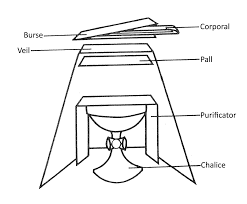
The Offertory, Preparing the Table, and The Chalice Stack
The Offertory
 After the Passing of the Peace, the congregation is seated for the Offertory. At Christ Church Anglican, the Offertory is marked with either instrumental or choral music. In the Prayer Book’s history, however, certain sentences of Scripture were appointed to signal the beginning of the Offertory. Here are a few of those passages from the 2019 Book of Common Prayer (p. 149):
After the Passing of the Peace, the congregation is seated for the Offertory. At Christ Church Anglican, the Offertory is marked with either instrumental or choral music. In the Prayer Book’s history, however, certain sentences of Scripture were appointed to signal the beginning of the Offertory. Here are a few of those passages from the 2019 Book of Common Prayer (p. 149):
Remember the words of the Lord Jesus, how he himself said, “It is more blessed to give than to receive.” Acts 20:35
As we have opportunity, let us do good to everyone, and especially to those who are of the household of faith. Gal. 6:10
Do not neglect to do good and to share what you have, for such sacrifices are pleasing to God. Heb. 13:16
Just as the Passing of the Peace is more than simply shaking hands with the people sitting around you, the Offertory is more than just passing the plate. The Offertory is an appointed time to offer all things to God. This Sunday, you will notice acolytes carrying a small cruet of wine and a paten of bread to the altar as the ushers bring forth the offering plates. Why? At its core, the Holy Eucharist is an offering of thanksgiving and praise to God for the life, death, and resurrection of Jesus Christ. The Offertory orients us toward that offering as we share our material and spiritual gifts with God and one another.
The Preparation of the Table
In the early Church, the table was not even brought out until after the catechumens (i.e., those preparing for baptism) were dismissed from the service. At that time, a Deacon would come forth to do precisely what your Deacons do every Sunday at CCA. As a servant of Christ, the Deacon unveils the unconsecrated elements and prepares the table for the Holy Eucharist. After disassembling the Stack (see below) and setting out the elements, the Deacon pours unconsecrated wine into the chalice, followed by a small amount of water. The Didache, the first-century teachings of the twelve apostles, commands those preparing the Table to give thanks over the elements in the following fashion:
First, concerning the cup:
We give you thanks, our Father, for the holy vine of your servant, David, which you have made known to us through your Servant, Jesus. Glory to you forever!
Concerning the bread:
We give you thanks, our Father, for the life and knowledge which you have made known to us through your Servant, Jesus. Glory to you forever! Just as this broken bread was scattered upon the mountain and then was gathered together and became one, so too may your church be gathered together from the ends of the earth into your kingdom; because the glory and the power are yours forever through Jesus Christ.
(From The Didache, Chapter IX)
The Chalice Stack
If you have been to CCA on a Sunday morning, you have seen the Chalice Stack. Prior to each service, our indefatigable Altar Guild places vestments over our empty chalice that match the liturgical color of the clergy’s vestments. Here is a breakdown of what is in the Chalice Stack:
 The Empty Chalice: the cup used during Communion
The Empty Chalice: the cup used during Communion
Purificator: a clean, linen cloth used to clean the chalice
Paten: a flat plate used to hold the priest’s host
The Priest’s Host: a large host, or piece of bread, used by the priest in celebrating the Eucharist
Pall: a flat square of starched linen that, literally, keeps the flies away from the chalice
Veil: a silk cloth draped over the paten, pall, and chalice
Burse: a silk “purse” containing a corporal
The Chalice Stack sits upon a corporal, a large, clean, linen cloth that contains all of the elements for the Eucharist.
Dcn. Bree Snow
